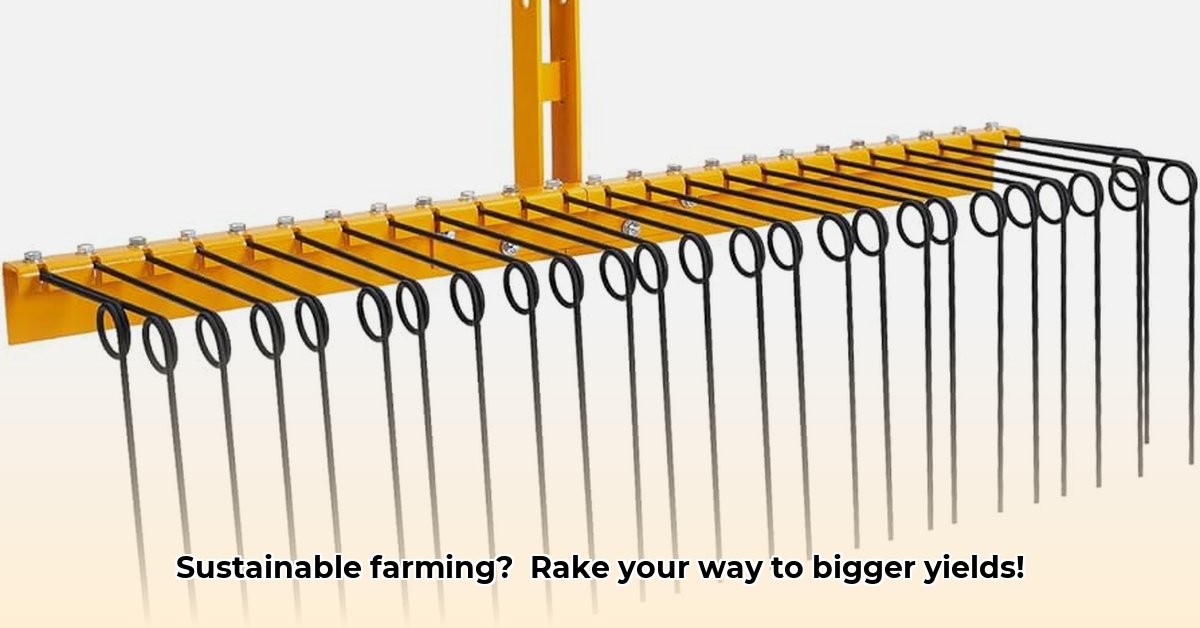
Efficient pine straw management is crucial for sustainable agriculture, and tractor-mounted pine straw rakes offer a significant advantage. This comprehensive guide will equip you with the knowledge to select, operate, and maintain these valuable tools, maximizing your returns while minimizing environmental impact. For more information on tractor mounted rakes, check out this helpful resource.
Types of Pine Straw Rakes: A Detailed Overview
Choosing the right pine straw rake depends on your operation's scale and needs. Several types exist, each with unique strengths:
Light-Duty Rakes: Ideal for small farms or landowners with limited acreage and primarily focused on mulching. These are generally more affordable with lower maintenance costs.
Medium-Duty Rakes: Suitable for medium-sized operations needing versatility for both mulching and baling. They offer a balance between capacity and maneuverability.
Heavy-Duty Rakes: Designed for large-scale operations and challenging terrains. These are built for durability and high capacity, particularly beneficial for large-scale pine straw baling operations.
Choosing Your Perfect Rake: A Decision-Making Framework
Selecting the right rake involves careful consideration of several factors:
Farm Size: Larger farms require high-capacity rakes capable of handling extensive acreage. Smaller farms can utilize more compact and maneuverable models. What's the optimal rake width for your acreage?
Budget: Rakes range significantly in price. Factor in not only the initial purchase cost but also anticipated maintenance and repair expenses. Consider leasing as an alternative to outright purchase; does this improve your ROI?
Terrain: Uneven or hilly terrain demands a rake designed for stability and maneuverability. Flat land offers greater flexibility in rake selection. How will terrain impact your rake's efficiency?
Desired Output: Will you primarily use the pine straw for mulch or baling? This dictates the required rake features and capacity. Will you sell the baled straw, or is mulching your sole objective?
Operating Your Pine Straw Rake: A Step-by-Step Guide
Safe and efficient operation is paramount. Adhere to these steps:
Pre-Operation Inspection: Before each use, thoroughly inspect the rake for loose parts, damage, and proper fluid levels.
Hitching Up: Carefully attach the rake to your tractor's three-point hitch, following the manufacturer's instructions precisely.
Adjustments: Adjust the rake's height and width to match your terrain and the thickness of the pine straw. This optimizes collection efficiency and prevents damage.
Operation: Begin at a slow pace, increasing speed as you gain confidence. Maintain consistent overlapping passes to ensure complete coverage.
Safety: Always wear appropriate safety gear, including eye protection and hearing protection. Be mindful of surroundings and potential obstacles.
Maintenance and Troubleshooting: Ensuring Longevity
Regular maintenance extends the lifespan of your rake and minimizes downtime:
Lubrication: Regularly lubricate moving parts according to the manufacturer's recommendations.
Inspections: After each use, inspect for wear, damage, and signs of potential problems.
Storage: Store the rake in a protected environment to prevent damage from the elements.
Common Issues & Solutions:
- Clogged Tines: Use a brush or hook to clear debris from the tines.
- Hydraulic Leaks: Immediately contact a qualified mechanic for repairs.
Cost-Benefit Analysis: Assessing Your Return on Investment (ROI)
The ROI of a pine straw rake is multifaceted. Consider:
Reduced Labor Costs: One operator with a rake can accomplish what requires many individuals manually. How many labor hours will this rake save you annually?
Increased Efficiency: Cover significantly more ground in less time. Estimate your increased acreage coverage per hour with the rake.
Potential Revenue: Baled pine straw is a marketable product. Research local market prices to estimate potential sales income.
Sustainability Considerations: Environmental Impact
Utilizing a pine straw rake contributes to sustainable agriculture practices by:
- Fire Mitigation: Removing excess pine straw reduces wildfire risks.
- Reduced Carbon Footprint: The rake's efficiency minimizes fuel consumption compared to manual methods.
- Waste Management: Explore eco-friendly options for using or disposing of collected straw (composting, biofuel).
Conclusion: Investing in Efficiency and Sustainability
Investing in a tractor-mounted pine straw rake represents a strategic move toward a more efficient and sustainable farming operation. While the initial investment requires careful consideration, the long-term benefits in terms of cost savings, environmental impact, and potential income often outweigh initial expenses. By following the guidance outlined in this guide, farmers and landowners can optimize their investment and contribute to a more environmentally responsible approach to land management.